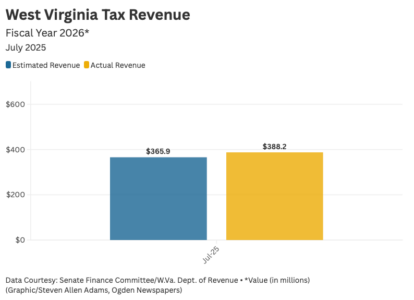Update: Dow Jumps 1,000 Points, S&P Up 2.6% Following US-China Tariff Truce

Trader Thomas McCauley works on the floor of the New York Stock Exchange, Friday, May 9, 2025. (AP Photo/Richard Drew)
NEW YORK (AP) — U.S. stocks are leaping Monday after China and the United States announced a 90-day truce in their trade war. They agreed to take down most of their tariffs that economists warned could start a recession and create shortages on U.S. store shelves.
The S&P 500 was 2.6% higher in early trading and back within 5.5% of its all-time high set in February. Since falling nearly 20% below that mark last month, the index has been roaring higher on hopes that President Donald Trump will lower his tariffs after reaching trade deals with other countries. The index, which sits at the heart of many 401(k) accounts, is back above where it was on April 2, Trump’s “Liberation Day,” when he announced stiff worldwide tariffs that caused worries to spike about a potentially self-inflicted recession.
The Dow Jones Industrial Average was up 957 points, or 2.3%, as of 9:35 a.m. Eastern time, and the Nasdaq composite was 3.6% higher.
It wasn’t just stocks surging following what one analyst called a “best case scenario” for US-China tariff talks. Crude oil prices jumped more than 3% because a global economy less weakened by tariffs would be hungrier for fuel. The value of the dollar climbed against everything from the euro to the Japanese yen to the Swiss franc. And Treasury yields jumped on expectations that the Federal Reserve won’t have to cut interest rates so deeply this year in order to protect the economy from the damage of tariffs.
Of course, conditions could change quickly again, as Wall Street has seen all too often in Trump’s on-again-off-again rollout of tariffs. Plus, the reduction in U.S. and China tariffs will last only 90 days. That’s to give the world’s two largest economies time for more talks followed last weekend’s negotiations in Geneva, Switzerland, that the U.S. side said had made ” substantial progress.”
Until then, a joint statement said the United States will cut tariffs on Chinese goods to 30% from as high as 145%. China said its tariffs on U.S. goods will fall to 10% from 125%. That follows a deal the United States announced last week with the United Kingdom that will bring down tariffs on many U.K. imports to 10%.
Big challenges remain in the negotiations between China and the United States, but the mood nevertheless was ebullient across Wall Street on Monday, and gains were widespread.
Apparel companies jumped to some of the biggest gains because much of their production is often in China and elsewhere in Asia. Lululemon leaped 10%, and Nike rose 7.3%.
Travel companies jumped on hopes that lower tariffs would encourage more customers to fly and feel comfortable enough to spend on trips. Carnival rose 8.9% and Norwegian Cruise Line rose 8%.
Retailers like Best Buy and Amazon jumped because they won’t have to pass on high costs caused by tariffs to their own customers. Both rose at least 7%.
In stock markets abroad, indexes rose across most of Europe and Asia, though often by less than the U.S. market.
India’s Sensex shot up 3.7% after India and Pakistan agreed to a truce after talks to defuse their most serious military confrontation in decades. The two armies have exchanged gunfire, artillery strikes, missiles and drones that killed dozens of people.
Pakistan’s KSE 100 surged more than 9% and trading was halted for one hour following a spike driven by the ceasefire and an International Monetary Fund decision Friday to disburse about $1 billion of a bailout package for its battered economy.
In the bond market, the yield on the 10-year Treasury jumped to 4.45% from 4.37% late Friday. The two-year yield, which more closely tracks expectations for what the Fed will do with interest rates, jumped even more. It rose to 3.99% from 3.88% as traders ratchet back expectations for how many cuts to rates the Fed may deliver this year. Many now see just two cuts this year, according to data from CME Group.
Original story
GENEVA (AP) — U.S. and Chinese officials said Monday they had reached a deal to roll back most of their recent tariffs and call a 90-day truce in their trade war for more talks on resolving their trade disputes.
Stock markets rose sharply as the globe’s two major economic powers took a step back from a clash that has unsettled the global economy.
U.S. Trade Representative Jamieson Greer said the U.S. agreed to drop its 145% tariff rate on Chinese goods by 115 percentage points to 30%, while China agreed to lower its rate on U.S. goods by the same amount to 10%.
Greer and Treasury Secretary Scott Bessent announced the tariff reductions at a news conference in Geneva.
The two officials struck a positive tone as they said the two sides had set up consultations to continue discussing their trade issues. Bessent said at the news briefing after two days of talks that the high tariff levels would have amounted to a complete blockage of each sides goods, an outcome neither side wants.
“The consensus from both delegations this weekend is neither side wants a decoupling,” Bessent said. “And what had occurred with these very high tariff … was an embargo, the equivalent of an embargo. And neither side wants that. We do want trade.”
“We want more balanced trade. And I think that both sides are committed to achieving that.”
The delegations, escorted around town and guarded by scores of Swiss police, met for at least a dozen hours on both days of the weekend at sun-baked 17th-century villa that serves as the official residence of the Swiss ambassador to the United Nations in Geneva.
At times, the delegation leaders broke away from their staffs and settled into sofas on the villa’s patios overlooking Lake Geneva, helping deepen personal ties in the effort to reach a much-sought deal.
China’s Commerce Ministry said the two sides agreed to cancel 91% in tariffs on each other’s goods and suspend another 24% in tariffs for 90 days, bringing the total reduction to 115 percentage points.
The ministry called the agreement an important step for the resolution of the two countries’ differences and said it lays the foundation for further cooperation.
“This initiative aligns with the expectations of producers and consumers in both countries and serves the interests of both nations as well as the common interests of the world,” a ministry statement said.
China hopes the U.S will stop “the erroneous practice of unilateral tariff hikes” and work with China to safeguard the development of their economic and trade relations, injecting more certainty and stability into the global economy, the ministry said.
The joint statement issued by the two countries said China also agreed to suspend or remove other measures it has taken since April 2 in response to the U.S. tariffs.
China has increased export controls on rare earths including some critical to the defense industry and added more American companies to its export control and unreliable entity lists, restricting their business with and in China.
The full impact on the complicated tariffs and other trade penalties enacted by Washington and Beijing remains unclear. And much depends on whether they will find ways to bridge longstanding differences during the 90-day suspension.
But investors rejoiced as trade envoys from the world’s two biggest economies blinked, finding ways to pull back from potentially massive disruptions to world trade and their own markets.
Futures for the S&P 500 jumped 2.6% and for the Dow Jones Industrial Average was up 2%. Oil prices surged more than $1.60 a barrel and the U.S. dollar gained against the euro and the Japanese yen.
“This is a substantial de-escalation,” said Mark Williams, chief Asia economist at Capital Economics. But he warned “there is no guarantee that the 90-day truce will give way to a lasting ceasefire.”
Jens Eskelund, president of the European Union Chamber of Commerce in China, welcomed the news but expressed caution. The tariffs only were suspended for 90 days and there is great uncertainty over what lies ahead, he said in a statement.
“Businesses need predictability to maintain normal operations and make investment decisions. The chamber therefore hopes to see both sides continue to engage in dialogue to resolve differences, and avoid taking measures that will disrupt global trade and result in collateral damage for those caught in the cross-fire,” Eskelund said.
Trump last month raised U.S. tariffs on China to a combined 145% and China retaliated by hitting American imports with a 125% levy. Tariffs that high essentially amount to the two countries boycotting each other’s products, disrupting trade that last year topped $660 billion.
The announcement by the U.S. and China sent shares surging, with U.S. futures jumping more than 2%. Hong Kong’s Hang Seng index surged nearly 3% and benchmarks in Germany and France were both up 0.7%
The Trump administration has imposed tariffs on countries worldwide, but its fight with China has been the most intense. Trump’s import taxes on goods from China include a 20% charge meant to pressure Beijing into doing more to stop the flow of the synthetic opioid fentanyl into the United States.
___
McHugh contributed from Frankfurt, Germany, Kurtenbach from Mito, Japan, and Moritsugu from Beijing.





